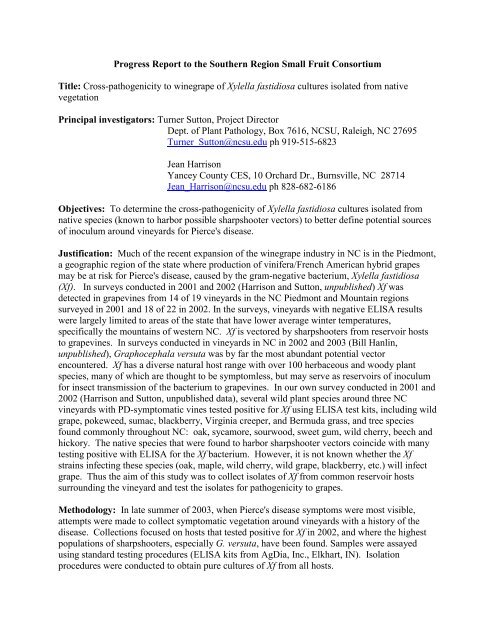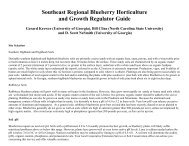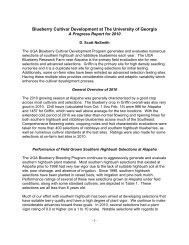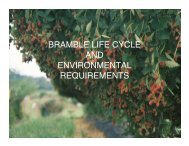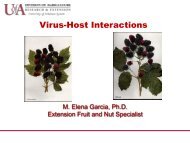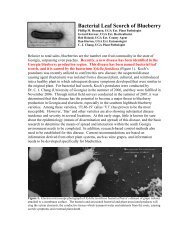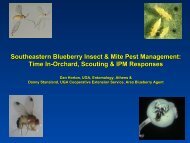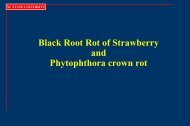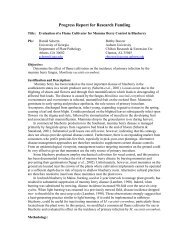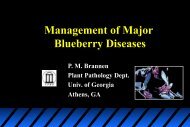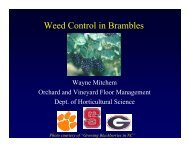Cross-pathogenicity to wine grape of Xylella fastidiosa cultures ...
Cross-pathogenicity to wine grape of Xylella fastidiosa cultures ...
Cross-pathogenicity to wine grape of Xylella fastidiosa cultures ...
Create successful ePaper yourself
Turn your PDF publications into a flip-book with our unique Google optimized e-Paper software.
Progress Report <strong>to</strong> the Southern Region Small Fruit ConsortiumTitle: <strong>Cross</strong>-<strong>pathogenicity</strong> <strong>to</strong> <strong>wine</strong><strong>grape</strong> <strong>of</strong> <strong>Xylella</strong> <strong>fastidiosa</strong> <strong>cultures</strong> isolated from nativevegetationPrincipal investiga<strong>to</strong>rs: Turner Sut<strong>to</strong>n, Project Direc<strong>to</strong>rDept. <strong>of</strong> Plant Pathology, Box 7616, NCSU, Raleigh, NC 27695Turner_Sut<strong>to</strong>n@ncsu.edu ph 919-515-6823Jean HarrisonYancey County CES, 10 Orchard Dr., Burnsville, NC 28714Jean_Harrison@ncsu.edu ph 828-682-6186Objectives: To determine the cross-<strong>pathogenicity</strong> <strong>of</strong> <strong>Xylella</strong> <strong>fastidiosa</strong> <strong>cultures</strong> isolated fromnative species (known <strong>to</strong> harbor possible sharpshooter vec<strong>to</strong>rs) <strong>to</strong> better define potential sources<strong>of</strong> inoculum around vineyards for Pierce's disease.Justification: Much <strong>of</strong> the recent expansion <strong>of</strong> the <strong>wine</strong><strong>grape</strong> industry in NC is in the Piedmont,a geographic region <strong>of</strong> the state where production <strong>of</strong> vinifera/French American hybrid <strong>grape</strong>smay be at risk for Pierce's disease, caused by the gram-negative bacterium, <strong>Xylella</strong> <strong>fastidiosa</strong>(Xf). In surveys conducted in 2001 and 2002 (Harrison and Sut<strong>to</strong>n, unpublished) Xf wasdetected in <strong>grape</strong>vines from 14 <strong>of</strong> 19 vineyards in the NC Piedmont and Mountain regionssurveyed in 2001 and 18 <strong>of</strong> 22 in 2002. In the surveys, vineyards with negative ELISA resultswere largely limited <strong>to</strong> areas <strong>of</strong> the state that have lower average winter temperatures,specifically the mountains <strong>of</strong> western NC. Xf is vec<strong>to</strong>red by sharpshooters from reservoir hosts<strong>to</strong> <strong>grape</strong>vines. In surveys conducted in vineyards in NC in 2002 and 2003 (Bill Hanlin,unpublished), Graphocephala versuta was by far the most abundant potential vec<strong>to</strong>rencountered. Xf has a diverse natural host range with over 100 herbaceous and woody plantspecies, many <strong>of</strong> which are thought <strong>to</strong> be symp<strong>to</strong>mless, but may serve as reservoirs <strong>of</strong> inoculumfor insect transmission <strong>of</strong> the bacterium <strong>to</strong> <strong>grape</strong>vines. In our own survey conducted in 2001 and2002 (Harrison and Sut<strong>to</strong>n, unpublished data), several wild plant species around three NCvineyards with PD-symp<strong>to</strong>matic vines tested positive for Xf using ELISA test kits, including wild<strong>grape</strong>, pokeweed, sumac, blackberry, Virginia creeper, and Bermuda grass, and tree speciesfound commonly throughout NC: oak, sycamore, sourwood, sweet gum, wild cherry, beech andhickory. The native species that were found <strong>to</strong> harbor sharpshooter vec<strong>to</strong>rs coincide with manytesting positive with ELISA for the Xf bacterium. However, it is not known whether the Xfstrains infecting these species (oak, maple, wild cherry, wild <strong>grape</strong>, blackberry, etc.) will infect<strong>grape</strong>. Thus the aim <strong>of</strong> this study was <strong>to</strong> collect isolates <strong>of</strong> Xf from common reservoir hostssurrounding the vineyard and test the isolates for <strong>pathogenicity</strong> <strong>to</strong> <strong>grape</strong>s.Methodology: In late summer <strong>of</strong> 2003, when Pierce's disease symp<strong>to</strong>ms were most visible,attempts were made <strong>to</strong> collect symp<strong>to</strong>matic vegetation around vineyards with a his<strong>to</strong>ry <strong>of</strong> thedisease. Collections focused on hosts that tested positive for Xf in 2002, and where the highestpopulations <strong>of</strong> sharpshooters, especially G. versuta, have been found. Samples were assayedusing standard testing procedures (ELISA kits from AgDia, Inc., Elkhart, IN). Isolationprocedures were conducted <strong>to</strong> obtain pure <strong>cultures</strong> <strong>of</strong> Xf from all hosts.
Results: Because <strong>of</strong> the wet, cool growing season, <strong>grape</strong>vines were not stressed and symp<strong>to</strong>mstypical <strong>of</strong> those induced by Xf did not appear until mid-September; also PD symp<strong>to</strong>ms weredifficult <strong>to</strong> assess statewide due <strong>to</strong> severe downy mildew disease. Many <strong>of</strong> the wild plant speciesunder investigation also appeared symp<strong>to</strong>mless, and results from ELISA test kits during earlySeptember were negative. Due <strong>to</strong> the limited amount <strong>of</strong> time between symp<strong>to</strong>m expression(mid-September) and the first killing frost (early Oc<strong>to</strong>ber), ELISA testing was halted, andsamples <strong>of</strong> native plant hosts that had tested positive with ELISA testing during the previousseason (2002) were collected and attempts were made <strong>to</strong> isolate Xf from them. Several differentcolony types were obtained from these isolations and are still being purified. Once pure, theisolates will be tested with ELISA kits <strong>to</strong> determine whether they are indeed Xf.Conclusions: At this time, we are uncertain as <strong>to</strong> whether the alternate hosts we sampled wereinfected with Xf. Even though these plants had tested positive for Xf in 2002 with ELISA kittesting, it is possible that populations <strong>of</strong> Xf in these same hosts were reduced or eliminated by themore severe winter temperatures in 2003, and as a result the bacterium may not be present inhigh enough numbers <strong>to</strong> be successfully isolated.Impact Statement: Vegetation management will be an important <strong>to</strong>ol <strong>to</strong> minimize the impact <strong>of</strong>Pierce’s disease. However, the relationship between reservoir hosts <strong>of</strong> Xf in NC and potentialsharpshooter vec<strong>to</strong>rs has not been elucidated in NC, and it is not yet clear which reservoir hostsare important sources <strong>of</strong> inoculum <strong>of</strong> Xf.Publications: none


